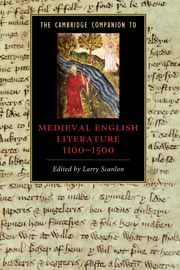9 - William Langland
from Part II - Authors
Published online by Cambridge University Press: 28 November 2009
Summary
In a volume such as this one, a chapter entitled “William Langland” is uniquely paradoxical. While not an anonymous (like “the Gawain-poet”), Langland remains alone among Middle English poets in failing to exist, in any meaningful way, outside his poem. Eloquent testimony to this liminal status appears in the frequent confusion, robust until well into the sixteenth century (and still occasional in modern critical discussions), in which this poet's title character, Piers Plowman, is often construed as the authorial (and not simply the authoritative) centre of his poetic work. As “William Langland,” this poet has no known biography. Reliable early fifteenth-century evidence indicates that the name may well be a pseudonym, assumed by one William Rokayle, from a gentry family with its seat at Shipton under Wychwood (Oxfordshire). He was probably the man of that name who was ordained to “first tonsure,” the lowest clerical order, in the Worcester diocese c. 1339 to 1341. Given canonical restrictions, this means Rokayle/Langland might have been born as late as 1331 to 1333, a period consonant with the date, 1325 to 1335, that may be inferred from the poem (in the B version, see Passus ii, line 47, and Passus i2, line 3).
We know nothing of Langland's life-occupations beyond what the poem itself implies: residence in London (cf. C 5.2, as well as citations from perhaps in-progress materials by London writers 1376-86) and an intense familiarity with clerical - not simply religious but also legal, administrative, and parliamentary - culture. Indeed, the only evidence for Langland’s protracted life comes from the survival of his poem in three distinct forms – A, B, and C versions – a first taste of the work’s many confusing multiplicities. The A version, the earliest, consists of three visions, conveyed in approximately 2500 lines, divided into ten sections or passus (Latin for “steps”), along with a prologue. The B version adds eight more dreams and ten more passus, in addition to reworking and expanding some of the material in the earlier passus, for a total of some 7,700 lines.
- Type
- Chapter
- Information
- The Cambridge Companion to Medieval English Literature 1100–1500 , pp. 125 - 138Publisher: Cambridge University PressPrint publication year: 2009
- 1
- Cited by

